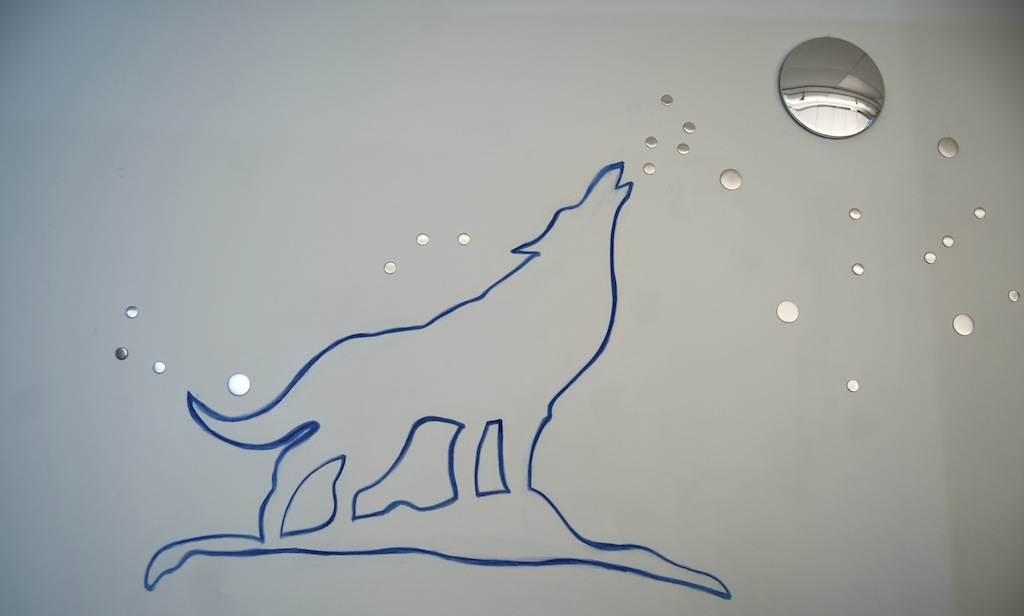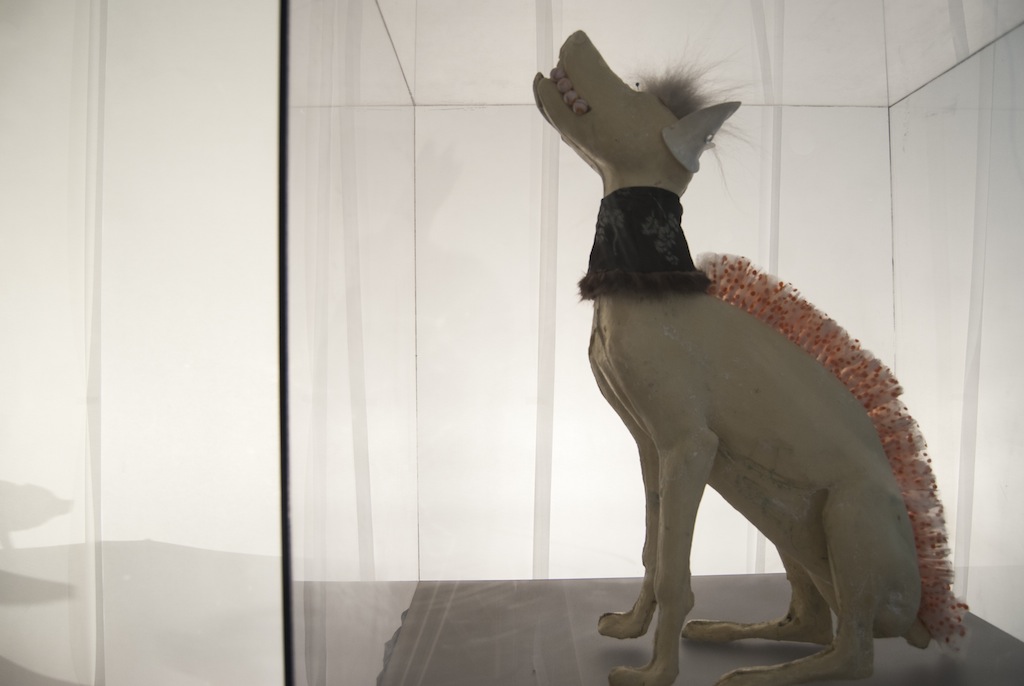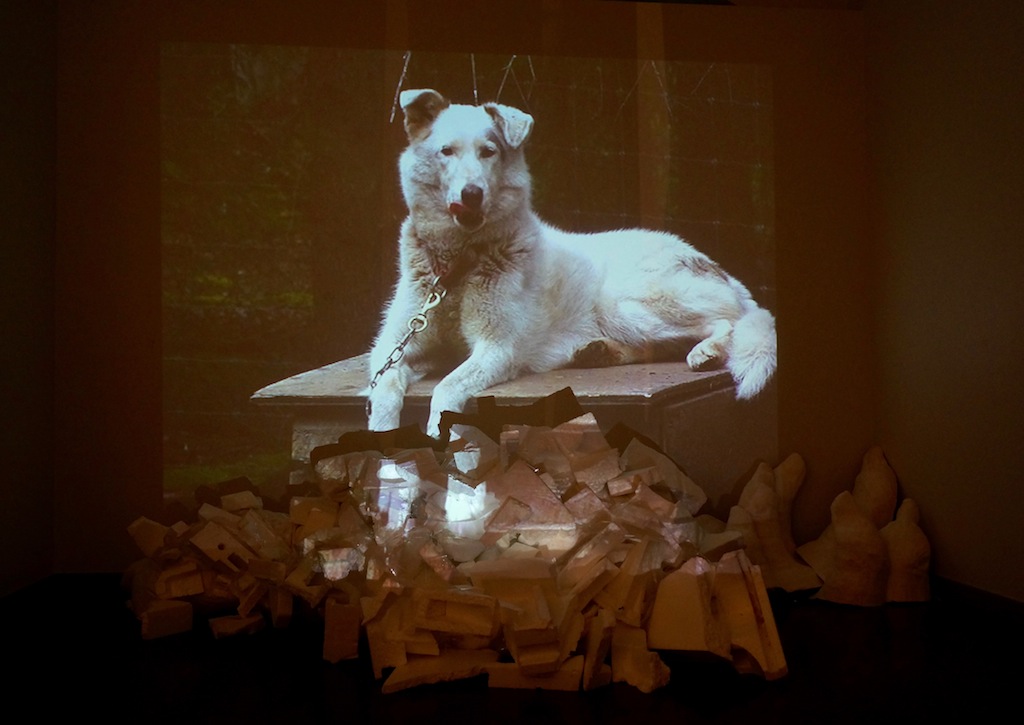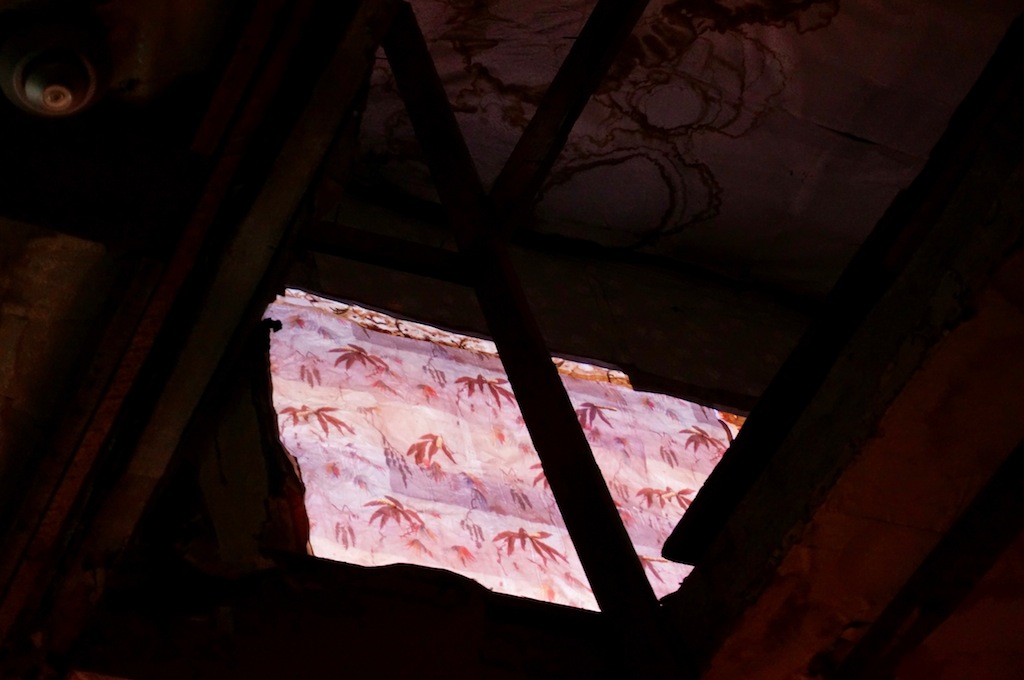Post-exhibition text for The Natural & The Manufactured 2016
The two artist duos creating work for The Natural & The Manufactured 2016 explored the overlaps between the perceivable and the imaginable. Despite knowing, for example, that pine siskins migrate between Northern Mexico and the Yukon, it is difficult to imagine flying those distances, at such windy heights. And hearing a story about finding and raising ten puppies might be just as hard to imagine in detail.
It’s a pleasure to try and imagine those kinds of journeys from the non-human participants’ point of view. Arguably, the act of attempting to see the world from another being’s perspective is one of the many personal, subjective interactions necessary to maintain empathy for other species. That empathy in turn can lead to discussions about how to balance the impacts of the manufactured on the natural.
We perceive many facts and realities about the natural world’s rhythms, but there is still so much more to imagine, to understand.
Kathleen Ritter employs an immersive, creative approach with her written response to Northern Howl and migratory (patterns). Part speculative fiction, part description of the two installations as time capsules, The Tour addresses how fragile is our knowledge of the natural world— and how robust.
The Tour
by Kathleen Ritter (bio available here)
My guide meets me at the edge of the town. I’ve been here a day and a half already, waiting, nursing feet worn with blisters. I stand up to greet her. She lifts her head and throws her arms around me in an unexpected embrace. “It’s been many months since we’ve had an outsider. Welcome.”
I wrestle my swollen feet into boots and stamp out the fire. We are standing on low ground, in the middle of the riverbed where I pitched camp. This place was once called the confluence: the place where the two rivers met. The riverbed, now completely dry, glistens in the sunlight. It is littered with bones, bleached white in the long days of summer, when the sun barely sets.
The riverbed is flat, and today it is the only passable route north. The ground elsewhere is dug up and turned over into heaving masses of gravel tailings from the dredges, and are not practical to cross on foot. Nothing grows here anymore. People rarely make the trip, not only because it is onerous, but because they are superstitious of the riverbed. My guide takes my hand and we start walking towards the old town. It’s only then that I realize she is blind. “How did you find me?” I ask.
“It was easy,” she replies, laughing. “There’s not much living around here these days.”
“Right. Of course.”
We walk together. The air is silent. Today birds don’t even fly overhead. They’ve changed their migration routes to avoid this area, just like the airplanes.
We hear the sound of our footsteps. I’ve gotten used to stepping on bones. At first, out of respect, I tried to avoid them, but there are too many. I hear them grinding under my boots with each step. During the long journey to come here I tempered my unease by trying to identify them, scientifically, matching them to animals I studied, animals now long gone. This skeleton is surely a salmon, I said to myself. This one must be the hind leg of a dog. There are human bones as well. I wondered about the people who lived here, the ones who didn’t make it to higher ground.
“You are studying the animals that were once here?”
I nod. “Yes.” I add, remembering that she can’t see.
“They never returned. The few animals that survived moved to higher ground. There were warning signs. My ancestors listened to the land rumbling and followed the animals.”
“They were lucky.”
“They were smart,” she stops, correcting me. “And resourceful—they learned how to cultivate enough food from what remained. The rest of the land is barren; some believe it’s haunted. The roads were too broken to fix, planes refused to land. They dropped food in for a while, but after time they stopped flying overhead. We became disconnected and isolated.” She speaks as if she lived through it herself. I know the story well, but her retelling makes it real.
The town sank four generations ago, when the Tintina and Denali fault lines ruptured within a few weeks of each other. The immediate impact was devastating. The earth shook, water rose up from the ground and covered the lowlands in a series of flash floods that were so unexpectedly toxic, they left the soil infertile. Only a few people at the epicentre remained—namely my guide’s relatives—but little is known about how they managed to survive.
Despite all this, a handful of buildings in the town were left standing. As the temperatures climbed in the years that followed the quakes, the permafrost thawed, and the land dried up. The ground became so uneven that the few remaining structures leaned and fell into each other, eventually collapsing into heaps of wooden slats. “I want to know about the dogs. Can you tell me about them?” I ask my guide. “There was a time when dogs outnumbered people in this town. They were everywhere. They were different colours and different breeds. Some were as large as wolves. You could hear them howling at night. One would start and others followed, until the night air was filled with a chorus of howls so loud, it shook the moon.” I close my eyes and try to imagine the sound of dogs howling.
“My great-great-grandmother had a dog. He followed her to high ground and never left her side. She would talk to him as if he were human. She would tell him everything: her thoughts, her feelings, even her secrets. They grew old together. When he passed away, she was devastated. He was the last dog ever seen.”
We are both silent for a moment.
“We are not sure when the animals will return. It might take a few more generations. Until then, my family will keep the exhibits open. We want to remember.”
We arrive in front of a building leaning so precariously to one side that half of the roof has slid off and lies in a heap in the adjacent lot. Flecks of pale green paint decorate the exterior slats of the facade, a hint of the colour it once was. The door has fallen off its hinges and remains permanently propped open. She invites me inside. It is dark and I can barely see.
She takes a battery out of her pocket. “You’ll need this,” she says wryly as she uses it to power up the room. The lights flicker and several images appear on the walls. I hear voices speaking. To the left on the ground, a mound of ice rises and falls, as if it is breathing. I jump.
“Don’t worry,” she giggles. “It’s not real.”
I kneel down and reach out a hand to touch it. It’s not cold—probably made of styrofoam. Its movement is mesmerizing. Above it are images of dogs projected on the wall. I’ve never seen a dog. I’ve only read descriptions of them. I stare at the changing images. Dogs are more varied than I expected.
My eyes begin to adjust as I stand up and look around the room. There are mirrors on the wall, connected with blue lines in the shape of a dog and a bear. She points up in their general direction. “These are called constellations. People used to believe that the stars in the night sky were connected in ways that resembled animals.”
“Yes, I know.” I say. Then, with curiosity, “When did your people stop believing there were animals in the sky?”
She shrugs. “When the animals left the land and the birds abandoned the sky, I suppose.”
Two vitrines contain sculptures of dogs. I take a closer look at one. It is made of plaster, a swath of fur on its back, and a rubber mask for the head. I walk over to the other and examine it. It’s also made of plaster and its head is raised, as if howling. There is a small patch of fur around its neck. It looks cold, and fake. “Is this really what they looked like?” I ask, skeptically.
“Of course,” she says with a dismissive wave, irritated. I feel embarrassed. Her family was the last to know dogs while I’ve only studied them in books. Still, I can’t help but think that some things have been lost in translation.
There is a fur coat splayed on the wall, a plaster animal head in the centre that could be a dog or a bear, I’m not sure which. Images of fur are projected overtop. In the centre of the room there is paper draped from the ceiling to the floor in a long oval. It is illuminated from inside, with shadows projected on the walls. Outlines of dogs dance across the paper as the shadows rotate. The voices I hear seem to come from inside the illuminated room. I stand closer, leaning in.
“Over the years my family recorded stories from everyone we knew who had a dog. Those are the voices you hear now.”
I listen to the stories. There was a dog who stole a turkey. A dog with a glass eye. A blind dog named Katie who was kind. There were stories of missing dogs and distraught owners. There was a dog pulled out of water by its owner. People spoke of their dogs with tenderness. They spoke of dogs curled up in bed with them. They all had names. I had read that people kept dogs as companions, but only now could I imagine it.
I take out my book to make some notes. “Would you mind if I stayed here for a while?” “Please. Stay as long as you like.”
My guide leaves and returns a few hours later with an armful of bones. She lays them in the corner. “I’m going to add these to the exhibit,” she tells me. “If you come next year, there will be more.” I doubt that I will make the journey again, but I agree nonetheless, not wanting to disappoint her.
“I want to show you another exhibit we made.” She takes my hand in hers, and leads me to the next building. It is equally dilapidated. “This one is dedicated to the birds.” We turn sideways to pass through the narrow entrance, and step inside. There are several rooms I can just make out by the light streaming through cracks in the wooden slatted exterior. The inside walls still have scraps of wallpaper on them, decorated with repeating motifs of flowers and plants, remnants of an extravagant past. They seem familiar, perhaps because I’ve come across diagrams of ornate flowers like these in my studies.
“What is this building?” I ask.
“It was once a brothel,” she tells me. “It was run by a woman from Paris who went by the name ‘Ruby’. Her clientele was mostly workers from the dredge camps, back in the day when there was still gold in the ground and the town was full of people mining it. We call this building ‘Ruby’s Place’.”
I look around and try to imagine what it would have been like. Fancy, no doubt. I hear birds chirping and follow the sound to the next room. Suddenly I see several birds, six or seven. They fly in. Each one perches on a different motif in the wallpaper. They are small and animated and loud. I check behind me to see if my guide is paying attention, and lean in furtively to touch one. Instead my fingers graze paper.
My guide hears me recoil and laughs. Nothing escapes her apparently. “Don’t get your hopes up—they are not real either. It’s a projection. We found a recording years ago.” They are convincing nonetheless. “What kind of birds are these?”
“Pine siskins and redpolls. They were a migratory species that used to pass through the Yukon in late summer.”
I watch the projection, captivated. The birds fly in and land on their perches, rest for a while, then fly away. I look up through a hole in the ceiling to the floor above. There is another projection, superimposed over another wallpaper pattern. When the birds leave one room, they arrive moments later in the other. I have the sense that they are flying all around the house, resting for moments in out-of-sight in rooms I can’t see.
My eyes are fixed on the moving image before me. When the birds leave, I wait anxiously for them to return, worried that their fleeting presence won’t allow enough time to commit their image to memory. The chirping that fills the room seems too loud for such small creatures, but my guide reassures me that this is accurate. These birds have powerful voices.
I look to my guide. “How long do you think these buildings will remain standing?” “We are not sure. Nothing here is stable. The ground continues to move, and land still slides from the hills into the valley. But we will keep these exhibits going for as long as it is possible. We were the last to see the animals, so it is our job to keep them alive in our memory.”
“I understand,” I tell her. “Thank you.”
My guide leaves me and I stay with the exhibits until the batteries run out. I place them under the floorboard at the entrance, as instructed. As I step back into the midnight sun and walk back towards the riverbed, I take stock of what I have seen. My mind is overwhelmed with images and sounds and textures. I prepare for the long journey back, bracing myself for the sound of my boots grinding over bones of the animals who once populated this land, those that may never return.





